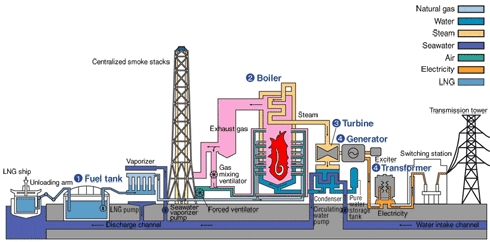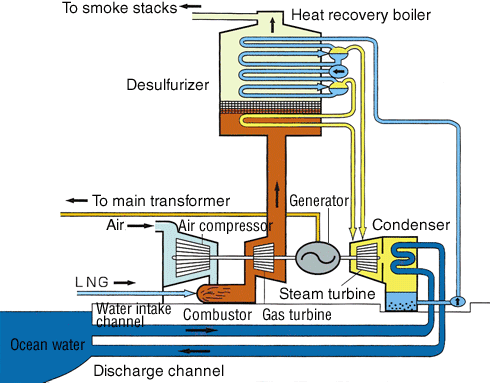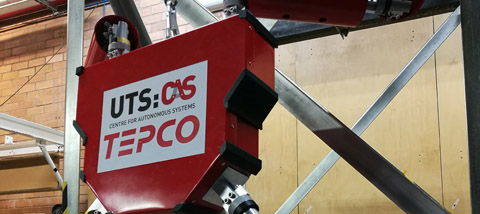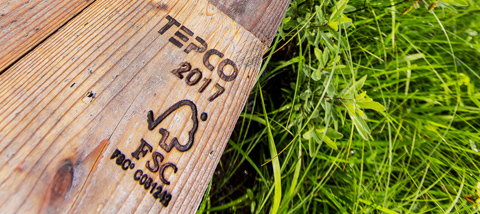Thermal power generation can respond flexibly to demand fluctuations, and plays a central role in supplying electric power. Backed by continuous innovation, TEPCO carries out new technology development and introduces new environment protection measures.
Thermal power plants use a wide variety of fuels based on the ability to procure them stably and economically as well as from an environmental standpoint. These include LNG (liquefied natural gas) and LPG (liquefied petroleum gas), which are clean energy sources containing no sulfur, along with petroleum fuels such as heavy oil, crude oil, and NGL (natural gas liquid), as well as coal.
How Thermal Power Generation Works
An ordinary thermal power plant burns fossil fuels, converts water to steam in a boiler, and drives a steam turbine to generate electricity.
Generation of Electricity by an Ordinary Thermal Power Plant (LNG-fired)

Combined Cycle (CC) Power Generation
Combined cycle power generation combines a gas turbine and steam turbine to generate electricity. Fuel is burned in compressed air to produce combustion gas, and the expansive force is used to drive a gas turbine, which in turn drives a generator. During this gas turbine power generation, heat is recovered from the exhaust gas and used to drive a steam turbine. The combination of gas turbine and steam generation is able to achieve high thermal efficiency of 47.2 percent, compared to the 43.2 percent of the latest conventional LNG thermal power system.
Producing Electricity by Combined Cycle Power Generation

Advanced Combined Cycle (ACC) Power Generation
ACC power generation is a dramatic improvement on CC generation, achieving greater energy saving, mobility, reliability, and environmental compatibility.
By raising the temperature of combustion gas at the gas turbine inlet from 1,100°C to 1,300°C, the gas turbine itself operates more efficiently and produces higher output. Since the temperature of exhaust gas from the gas turbine also rises, it becomes possible to incorporate a reheating cycle in the steam turbine phase, reheating and using the steam after it has driven the turbine. With the resulting improvement in steam turbine efficiency, ACC power generation achieves thermal efficiency of 54 to 55 percent.
Producing Electricity by ACC Generation

1,500��C-class Combined Cycle (MACC) Power Generation
Based on the ACC power generation approach, this method further raises the gas turbine inlet temperature for additional improvement in efficiency and generating capacity. With the development of new gas turbine insulation material, a gas turbine steam cooling method, and other technologies, it has been possible to raise the temperature to 1,500��C, achieving thermal efficiency of around 59 percent.
















